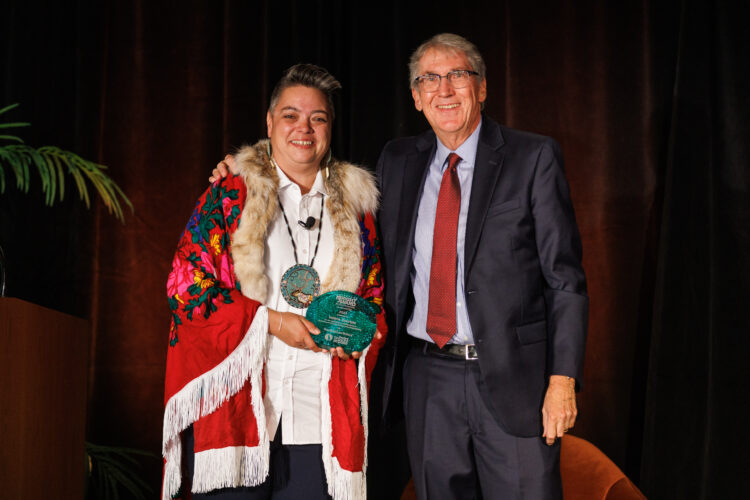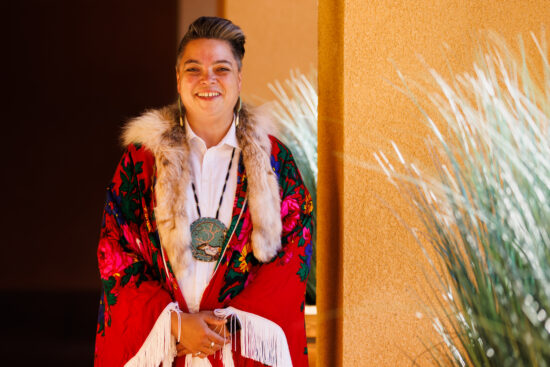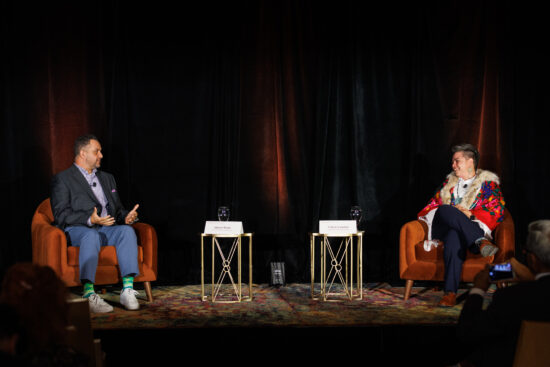Stanford University’s Bright Award Celebration Honors Champion of Indigenous-Led Conservation Efforts
Valérie Courtois, a leader in the movement for Indigenous-led conservation and land stewardship, received Stanford University’s highest environmental prize, the Bright Award for Environmental Sustainability, during an on-campus reception and ceremony on October 2. The evening event marked the 11th anniversary of the annual award, established by a gift from Stanford Law School (SLS) alumnus and lifelong conservationist Raymond E. Bright, JD ’59, who passed away in 2011.

The Bright Award winner is selected from one of 10 rotating regions worldwide based on recommendations from regional consultants and a nominating committee composed of SLS faculty and students. The committee is led by Stanford Law’s Barton “Buzz” Thompson, Jr., the Robert E. Paradise professor in natural resources law and a professor at the Doerr School of Sustainability.
At the start of the event, Thompson welcomed the attendees, including several members of the Bright family. He noted that Courtois, a member of the Innu Nation, is not just at the forefront of Indigenous-led conservation and land stewardship efforts in her native Canada, she is one of the world’s leaders in the movement. “What Valérie is able to do is to connect Indigenous self-determination and nationhood with the conservation of vital ecosystems,” Thomson said. Courtois’ work is not merely about advocating, he continued, but about making sure there are “boots on the ground, actually doing the work,” which is ultimately what the Bright Award is intended to honor.
‘If We Take Care of the Land, the Land Takes Care of Us’
Courtois is the founding executive director of Canada’s Indigenous Leadership Initiative (ILI), which supports Indigenous Nations (often referred to as First Nations) in caring for their lands and waters, primarily in Canada’s boreal forest, the largest intact forest left in the world. ILI advocates at the provincial, territorial, and federal levels to secure recognition and long-term funding for Indigenous-led conservation and stewardship initiatives.
ILI’s goal, Courtois explained in a speech to event attendees, is not to create top-down programs, but rather to support First Nations in their own initiatives. This includes the Indigenous Guardians, who serve as the “eyes and ears on the ground,” planning and managing Indigenous Protected and Conserved Areas, restoring animals and plants, testing water quality, and monitoring development on behalf of their nations. Thanks in part to Courtois’ and ILI’s efforts, there are more than 170 Indigenous Guardian programs in Canada.

Courtois said she “has the privilege of being part of a growing movement in Canada and around the globe that is creating solutions to some of the biggest challenges of our time, from climate change to social justice.”
“But the rock stars, they’re the ones on the ground,” she said. “The rock stars are the elders who share their knowledge, the Guardians who help restore caribou herds, and young leaders who are establishing new Indigenous Protected and Conserved Areas. The rock stars are our leaders and nations who fought for generations to be who we are, despite the efforts of genocide and colonialism in Canada, the impacts of which are still felt every day.”
While addressing the pressing challenges facing her Innu homeland, Canada, and the world, Courtois nevertheless sounded optimistic notes throughout the evening. “I’ve seen firsthand the devastating effects of climate change and loss of biodiversity across what is now known as Canada, but I’ve also seen something else and something that I really believe can help to stem the tide. It is not a technology, it is not a policy made in Ottawa or D.C., it is the fundamental understanding that is expressed by our elders this way: ‘If we take care of the land, the land takes care of us.’”
The U.S. and Canada Must Lead the Way
Following her remarks, Coutois sat for an on-stage interview with Shawn Watts, director of U.S. Strategy for The Christensen Fund, a non-profit that supports Indigenous peoples in advancing their rights, dignity, and self determination. Watts is also director of the Tribal Judicial Support Clinic at the University of Kansas School of Law and a member of the Cherokee Nation of Oklahoma.

Among other topics, Courtois and Watts discussed Canada’s leading role worldwide with regard to Indigenous-led conservation efforts. Both Canada and the United States have a critical role to play in showing the world that conservation and economic development go hand in hand, Courtois said. “Conservation can be a part of the economic model, especially in places like Canada and the U.S., which are two of the largest countries in the world with the largest intact landscapes in the world,” she said. “We are countries of law and rights and so if anybody in the world should get it right, it is us. If we get it right, we can serve as a beacon for others.”
Read More About Valérie Courtois
About Stanford Law School
Stanford Law School is one of the nation’s leading institutions for legal scholarship and education. Its alumni are among the most influential decision makers in law, politics, business, and high technology. Faculty members argue before the Supreme Court, testify before Congress, produce outstanding legal scholarship and empirical analysis, and contribute regularly to the nation’s press as legal and policy experts. Stanford Law School has established a model for legal education that provides rigorous interdisciplinary training, hands-on experience, global perspective, and focus on public service, spearheading a movement for change.

